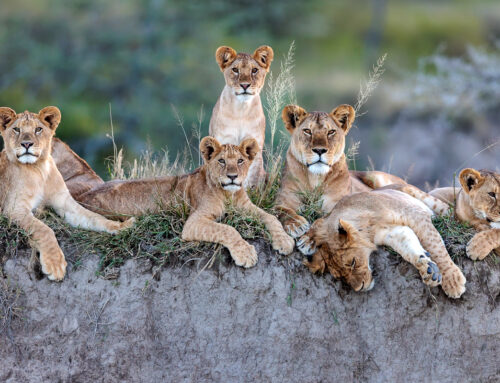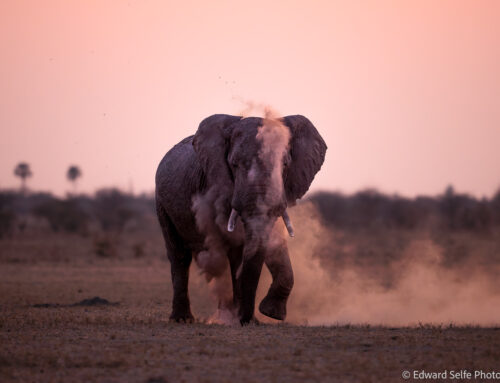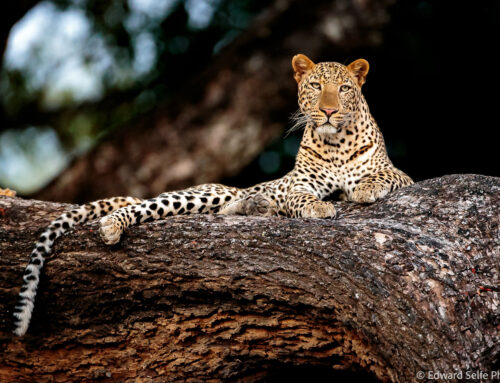Despite being the icon of Africa, savannah elephants are among the most difficult species to photograph well. I think there are four approaches which work effectively: family and group shots; behaviour; close ups and elephant-scapes. There are certainly other techniques which can be used too, but these are tried and tested methods which I know will yield good results.
Starting with family and group shots with captions to explain the thinking behind each image.
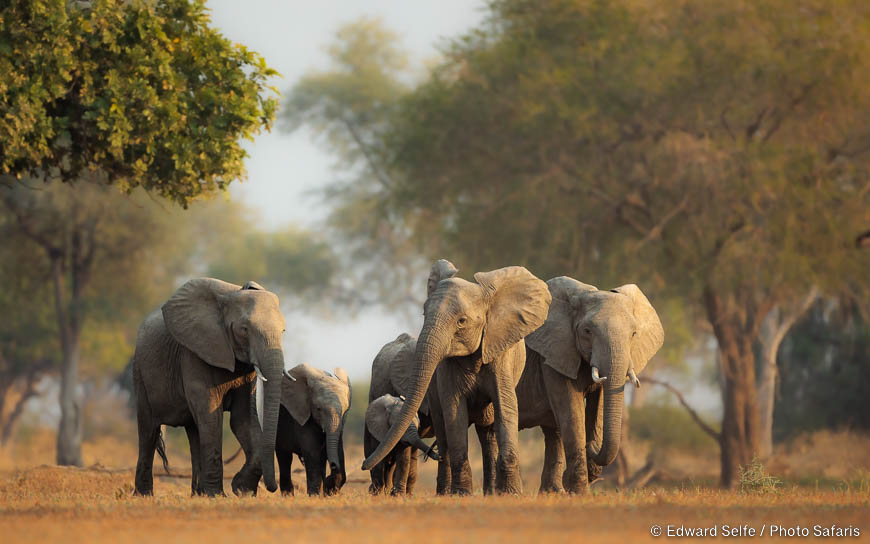
A low angle and a long lens allowed me to capture this family as they crossed a large floodplain. The lead female was continually checking side to side to ensure that the youngsters were following, which gives a dynamic element to the shot. There is a soft frame of trees around them and, crucially, none of the branches obstruct the background behind the subjects.
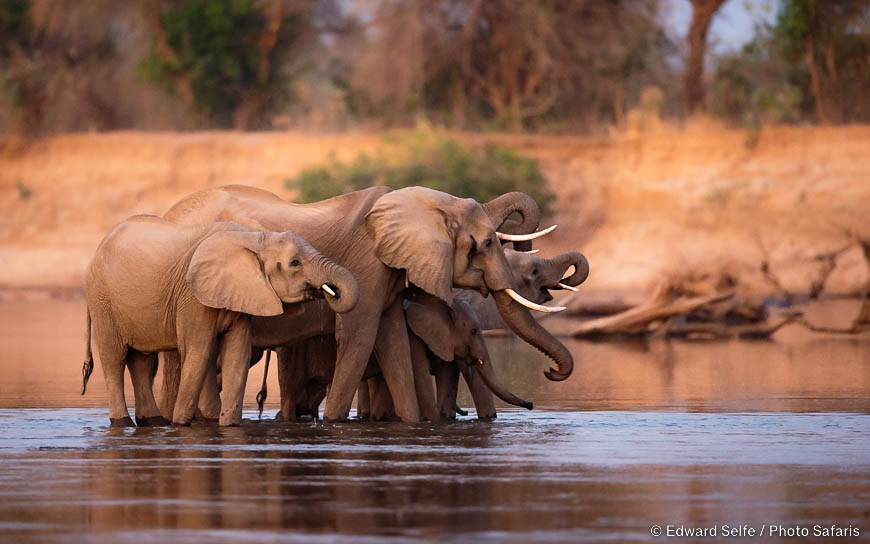
As this family herd headed to the water to drink, I moved as far ahead as I could. It’s important that when they drink, you can see their ‘faces’ and ideally, the faces of those behind the front elephant. In this shot, the soft post-sunset light is very flattering and avoids any hard shadows.
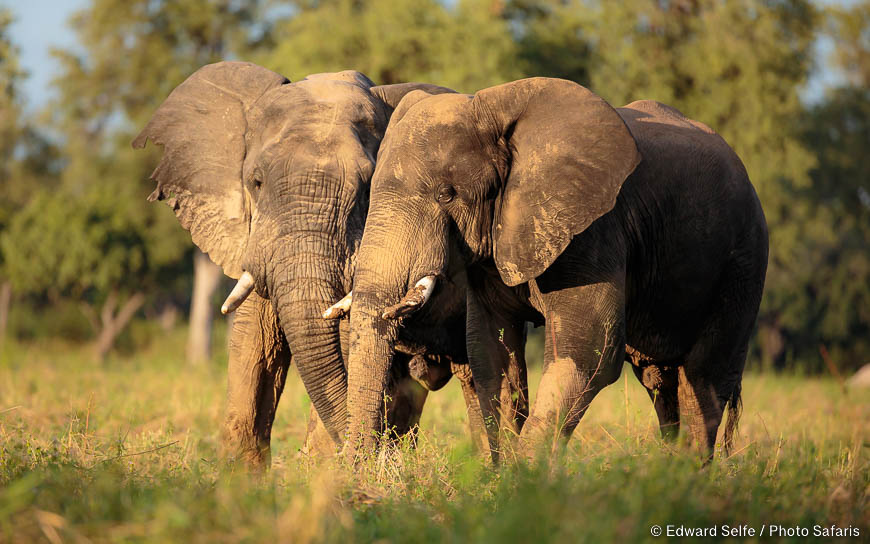
Two big bulls feed peacefully in the most spectacular early-dry-season light. When their trunks came together, perhaps to feed on the same clump of herbs, I knew that the overlap of their heads would make a beautiful frame.
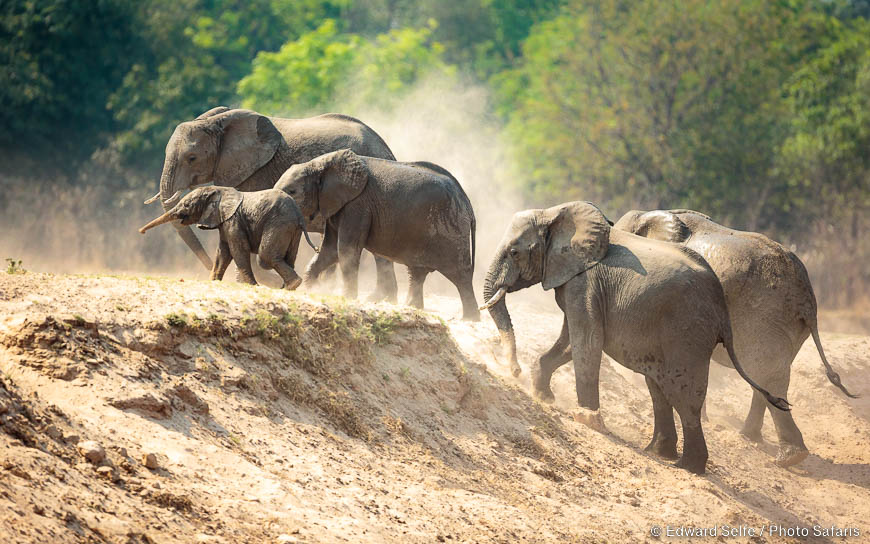
As these elephants climbed the bank after drinking at the river, they started to dust themselves in the soft sand. The moment when the herd was halfway up the bank seemed ideal as the levels created some flow in the image. The calf’s outstretched trunk was a beautiful additional touch that came at just the right moment.
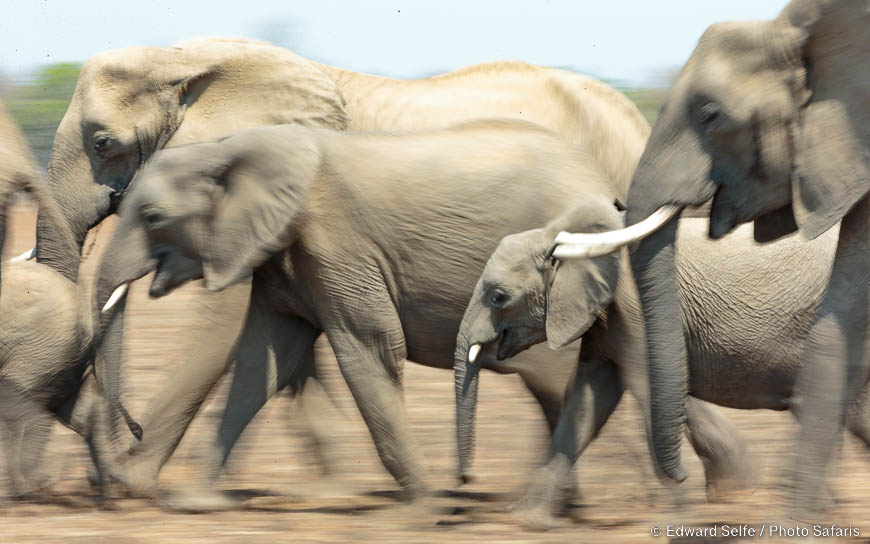
The light was a bit harsh when this herd of elephants came towards us one morning in the South Luangwa. I decided to use a slow shutter speed and introduce some blur and motion to the frame. I focused on the youngster halfway into the group and tracked his movement as he passed. From the 15 frames, all shot at 1/30sec, this was the best frame as the calf’s eye was sharp and there was pleasing blur in the legs of all the others.
It is undoubtedly elephants’ complex social systems and readily observable relationships which makes them so enjoyable to spend time with. Capturing moments when these relationships are displayed is a great way to bring an extra appeal to your images. Equally, moments when they display their impressive size (or the ways in which they modify and control their environment) are great to capture.
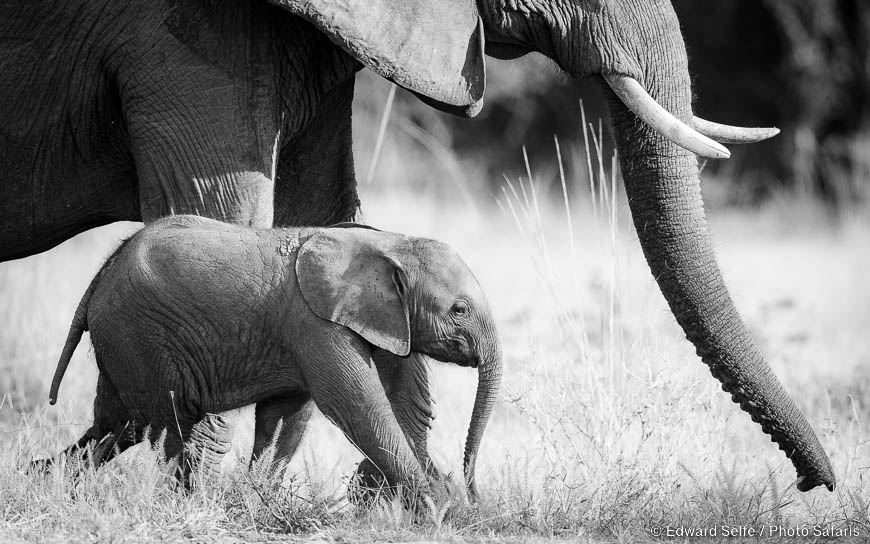
As these elephants approached me, I felt the temptation to reach for a wider lens. I hesitated, and then chose to keep my longer lens and lie across the seat to get a lower angle of view. As the calf passed me, I saw its small shape framed by his mother. Cutting out the mother’s eye means that the calf’s face draws the viewer’s attention and there is no distraction from a second eye high up in the frame.
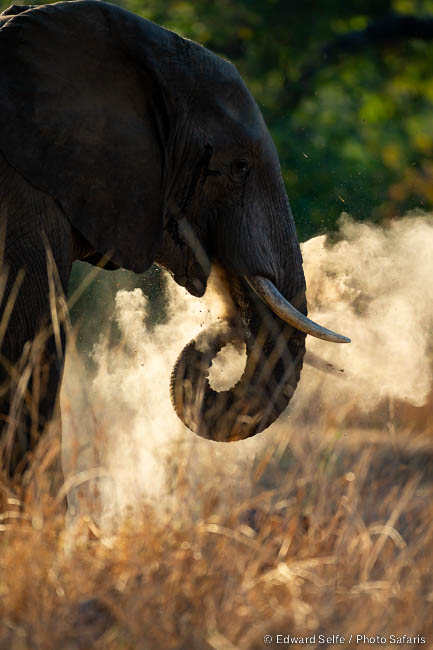
The unmistakable shape of an elephant’s curled trunk. Backlit, dusty and high contrast; the challenge here is not to make a nice image, since the conditions are perfect, but to ensure accurate focus. I would choose not the eye of the elephant, but the tusk where there is more contrast.
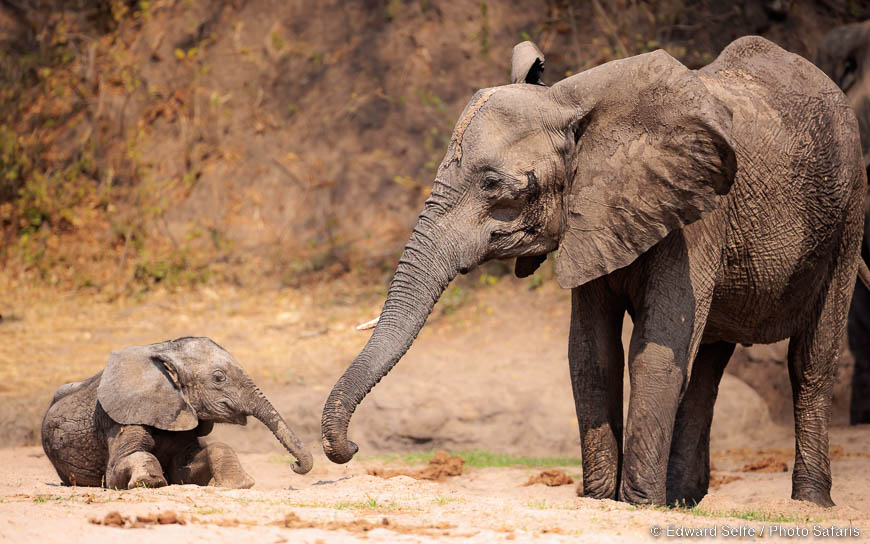
When this youngster took a tumble in the soft sand near a waterhole, there was an immediate reaction from his herd. I missed the moment when they helped him get up, but he quickly realised that he got lots of attention from the experience. So he did it again! This time, only one adult came to help, reaching her trunk out to reassure him.
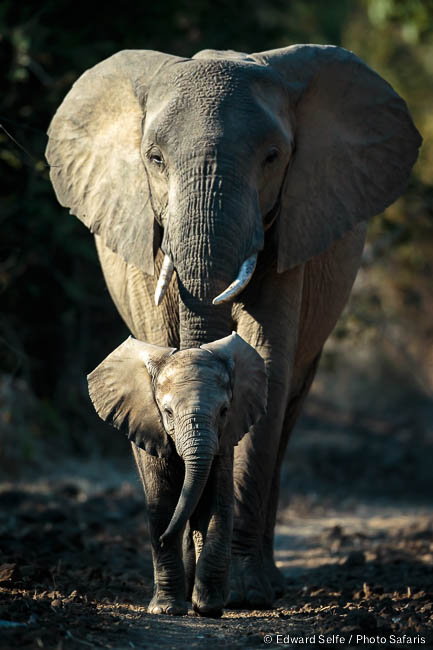
Strong sidelight can be tricky with large, dark creatures such as elephants. I saw these two approaching down a track, so I stopped and talked to my guests about the opportunity. We needed the light — which was filtered through the bushes on their right — to hit both mother and calf simultaneously and for their ears to be open and visible. Fortunately, they heard me talking and flared their ears, and then we just had to wait for the light.
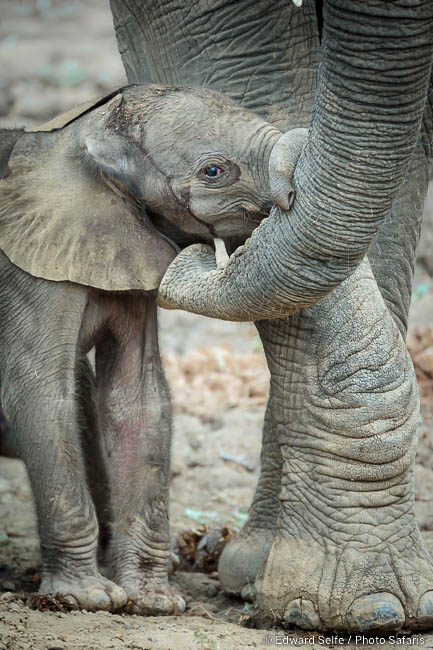
An unforgettable morning with a new-born elephant calf, still bloody from the birth. As he struggled to stand, the mother caressed him with her trunk, and repeatedly their trunks intertwined. I cropped a vertical out of the horizontal image, preferring to keep the focus solely on that small interaction.
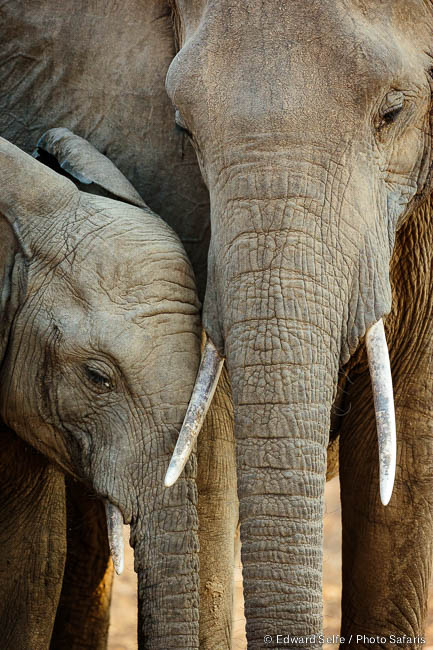
While snoozing in the shade, these two elephants dropped their trunks to the ground, stretching them and making them run parallel. The overlap of tusk and forehead, plus the even balance of the shot makes for a nice portrait. interestingly this shot was taken at about 15:00 when the light was harsh and the elephants were standing in the shade of a single tree. By getting close, and cutting out any bight highlights behind, we could still shoot even at this time of day.
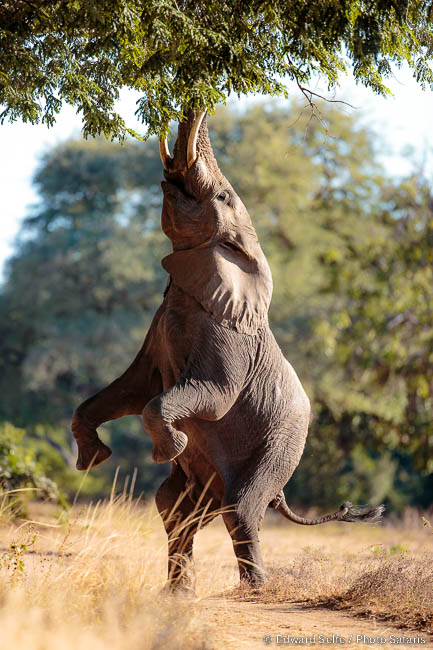
In the South Luangwa, elephants very rarely stand on their hind legs. When I saw this young male attempt to do so, I pulled back so that I could use a long lens and isolate him with a shallow depth of field…I wanted no distractions from the extraordinary effort that he must undertake to pull off such a move.
When a photographer has a chance to get very close to elephants, there are two choices. It’s possible to use a very wide lens to create a dramatic image where the elephant’s size in his surroundings is emphasised, or s/he can reach for a long lens and take the chance to capture small parts of the elephant’s huge bulk. Ears, eyes, tusks, tails and trunks all make good subjects but I always look for new angles and ideas too.
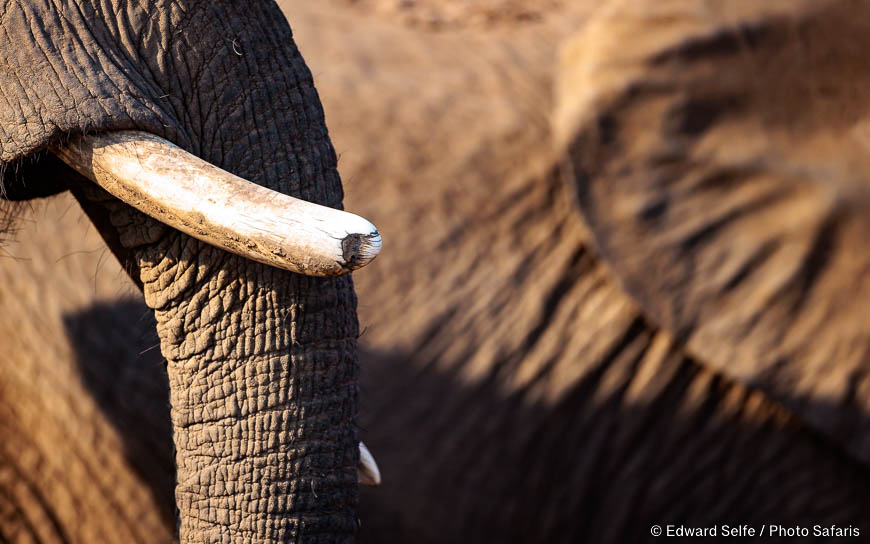
I liked this situation as the patterns and textures of the distant elephant make up the background. It also allowed me to use a shallow depth of field which is a pleasing effect in photograhy.
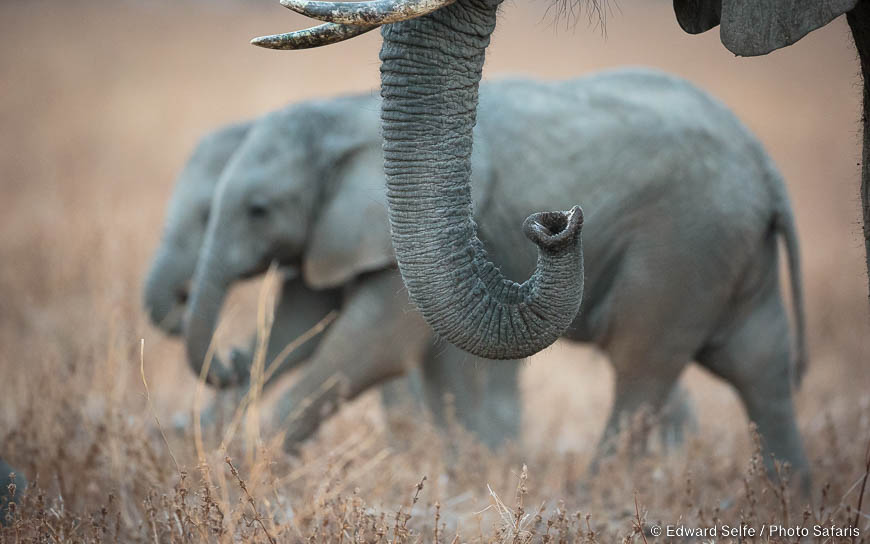
A variation on the theme above, playing with textures, ideas and overlapping body parts.
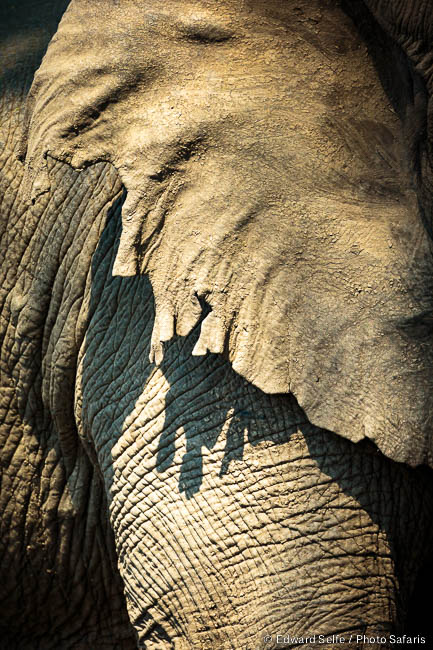
Elephants’ ears are perhaps the body-part most featured in close-up shots…and it’s clear to see why. There is great shape, colour and the skin has a different surface texture quality from the skin on the shoulder behind. In this shot, I loved the way the torn ear made beautiful patterns on the leg below….
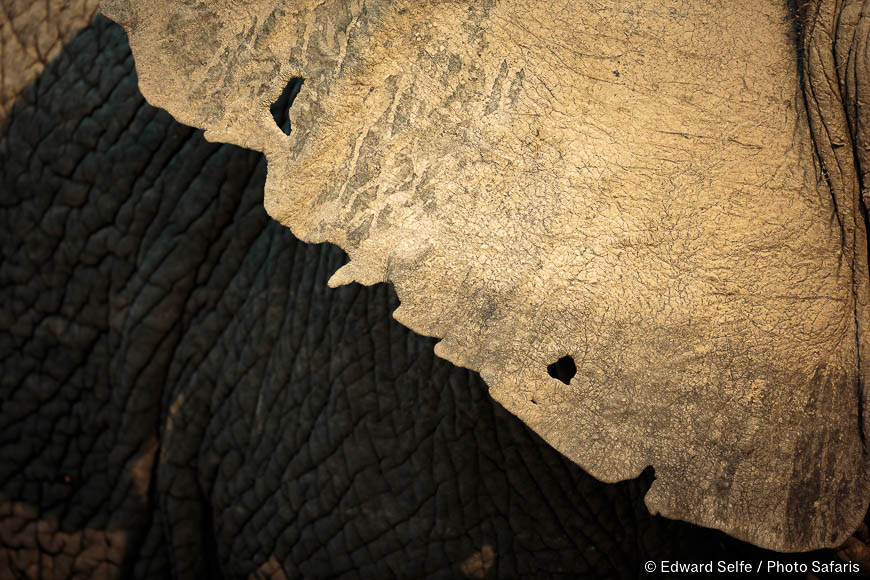
…and here I had the chance to play with light and shadow….
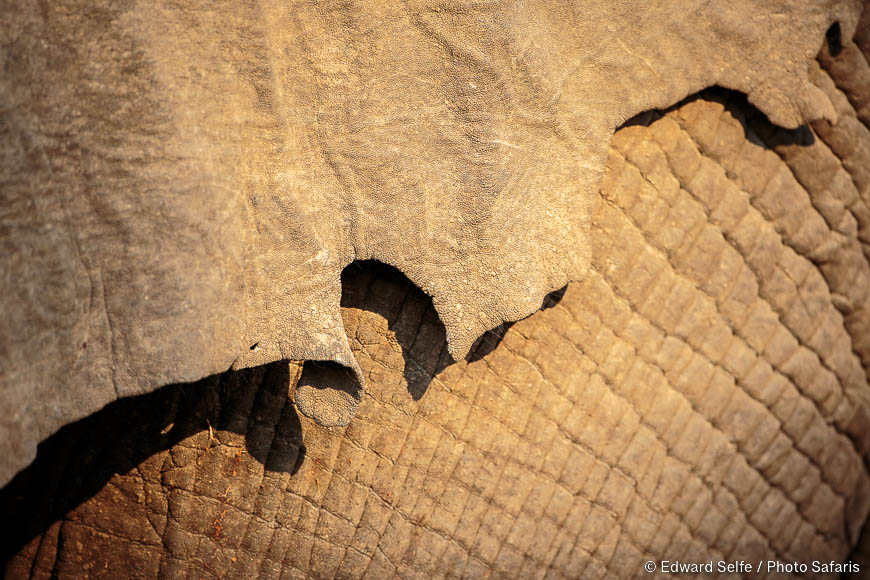
….and contrasting textures….
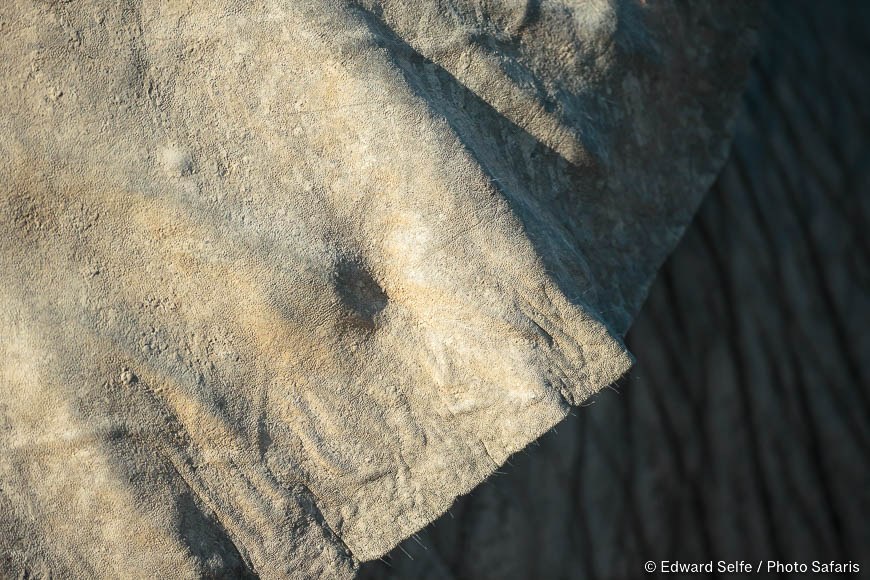
…and side light…
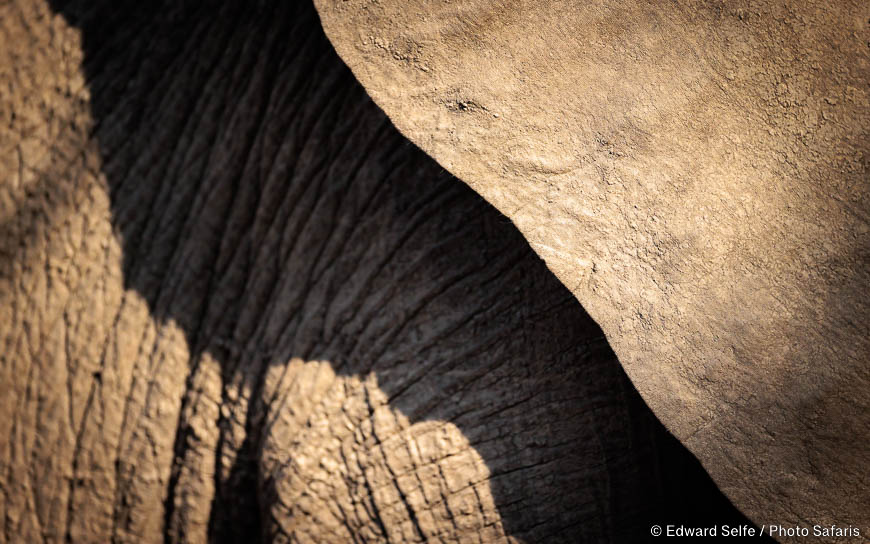
…and repeating patterns. I like them all and I am always looking out for ways to enlarge my portfolio of close up such as this.
Perhaps because we are all introduced to elephants in children’s books and TV programs when we are young, and perhaps because it is such a distinctive shape, elephants make great subject for animalscapes, where they are dwarfed in their landscape and form just a small part of a larger image. To achieve images like this, I always look further into the distance, choosing subjects and compositions from 100-500m away.
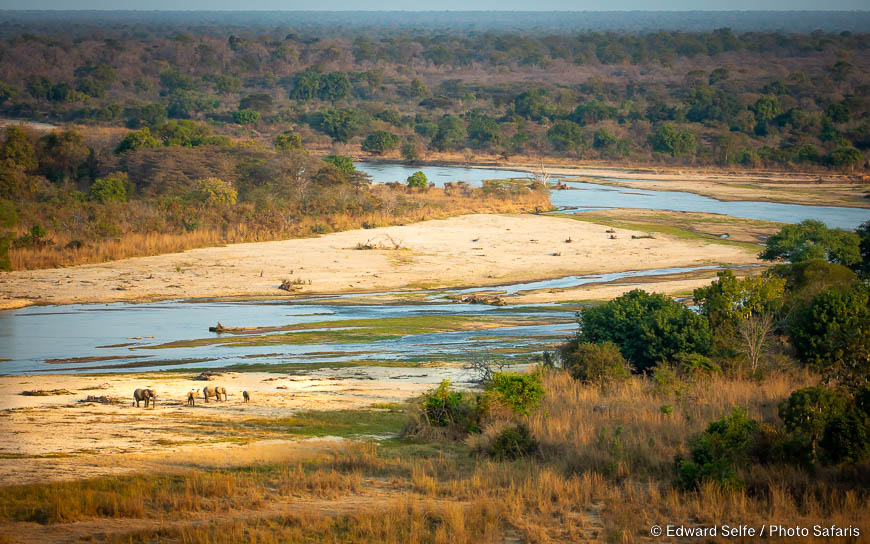
I was circling in a small aircraft over the North Luangwa National Park. The elephants on the beach in the foreground were the final touch in an already beautiful landscape scene of the Mwaleshi River flowing away in to the distance. Their dark shapes and location in the frame, combined with the good fortune that they were out in the open, make the image work.
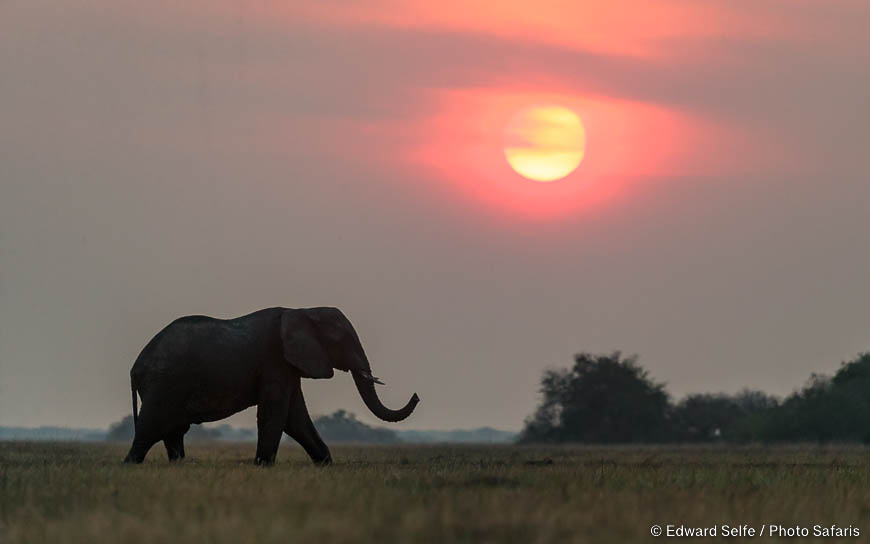
On the dusty plains of the Kafue National Park, I shot this frame of a large bull elephant. It’s almost a silhouette…with just a little detail in his flanks visible. But the silhouette is much improved by the raised trunk tip which points towards the setting sun and adds so much to the moment. Had he raised this trunk 5 paces later, it would have been lost against the dark shrubs in the distance.
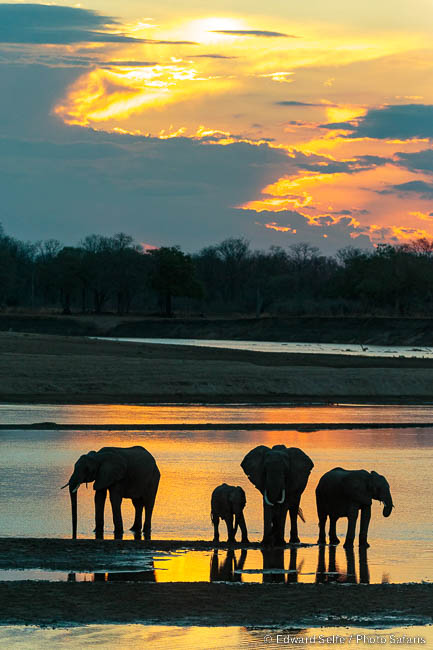
I could barely believe my eyes when I saw the opportunity which this scene presented in October 2019. The sun was setting behind the elephants, and the sunset promised to be very special. The only problem was that the herd was facing away from us. I positioned the vehicle and we waited, taking test shots to check the light level, until finally all 4 turned to face us and the shot was made. It was important in this shot that the lines of sand in the river did not bisect the elephants — so we needed height to separate the elephants’ backs from the sand bar above them.
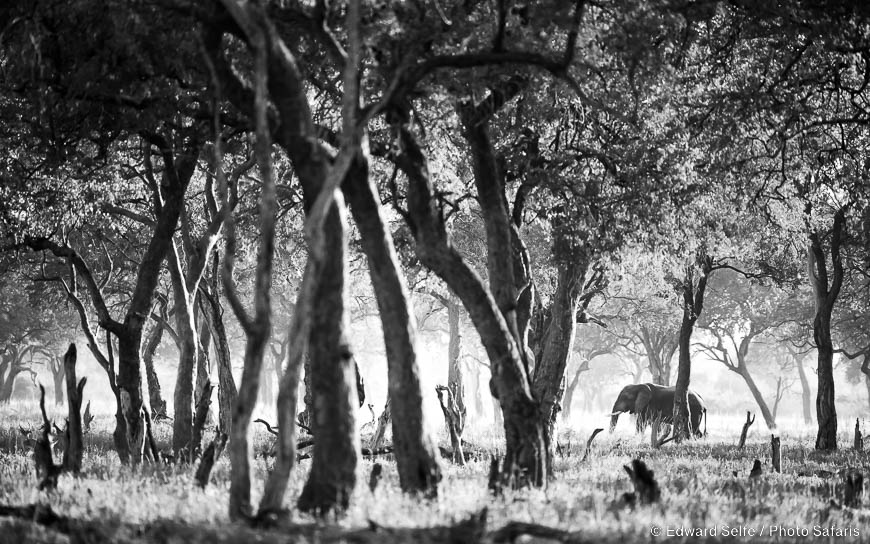
Making up perhaps 5% of the frame, this large bull elephant has just enough “weight” in the shot to draw viewers’ eyes through the forest and deep into the frame.
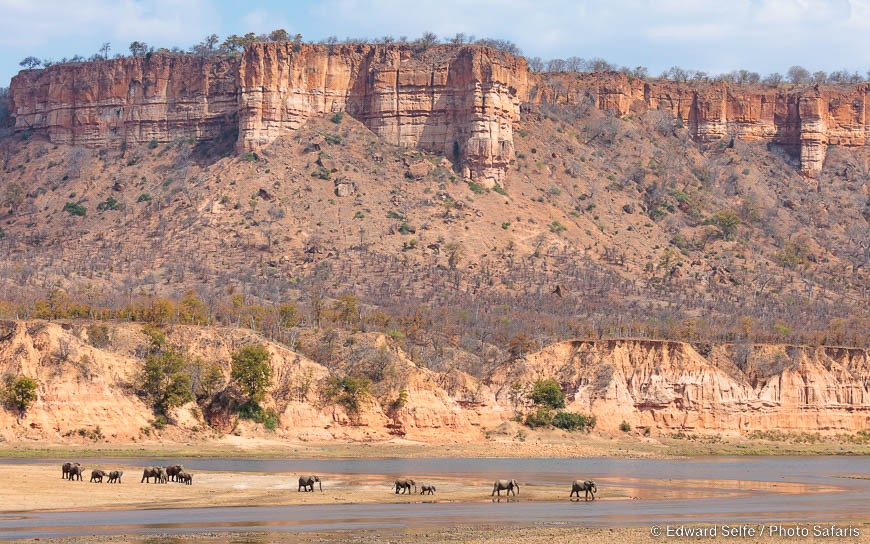
The sand cliffs of Gonarezhou National Park are its most famous feature, along with massive herds of elephants. This group appeared at lunchtime, fortunately on an overcast day, and spread themselves evenly across the beach as they headed to drink. Good luck for me as it allowed me to keep them very small in the frame, show off the full size of the cliffs, but not lose their identity at the bottom.
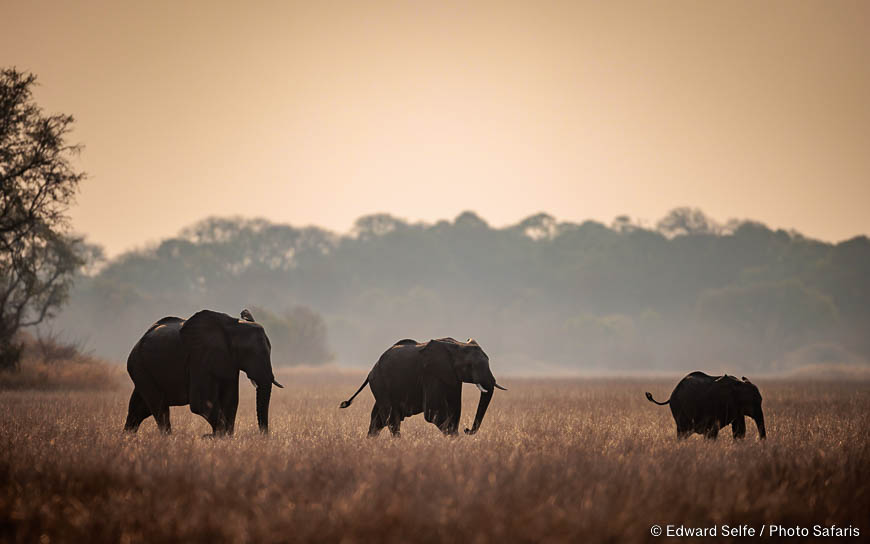
The central elephant is important in this frame. It is immediately recognisable as an elephant with a clean silhouette. The other two are less defined but can be resolved with the help of the central one; the heat and the sense of movement is clear as they move across Busanga plains towards the water.
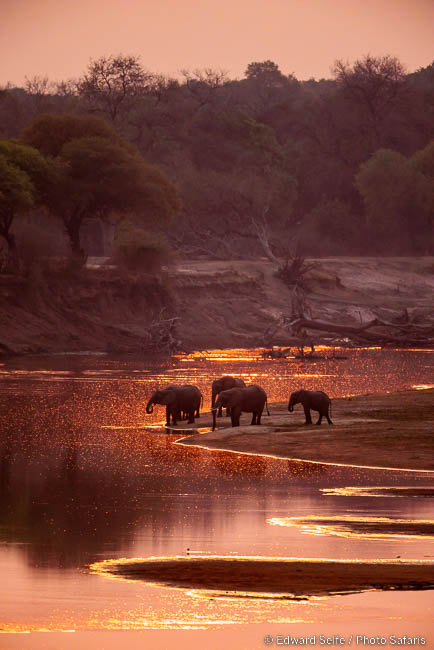
Distant elephants, but with enough going on in the surroundings to keep the eye moving across the frame long after the initial focus point has been passed over.
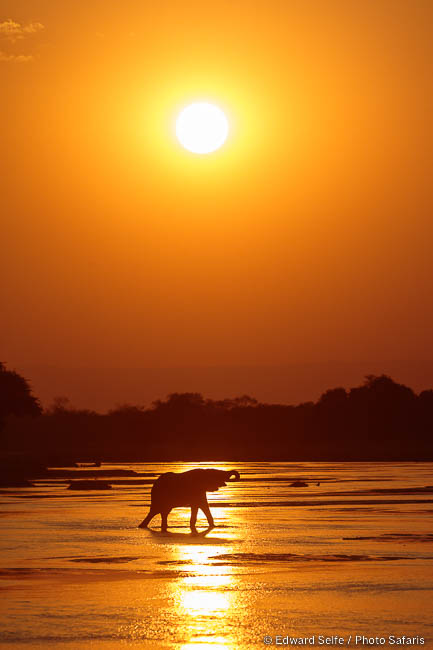
Clean, balanced, simple elephant silhouette. If there had just been a stream of droplets falling from its mouth!
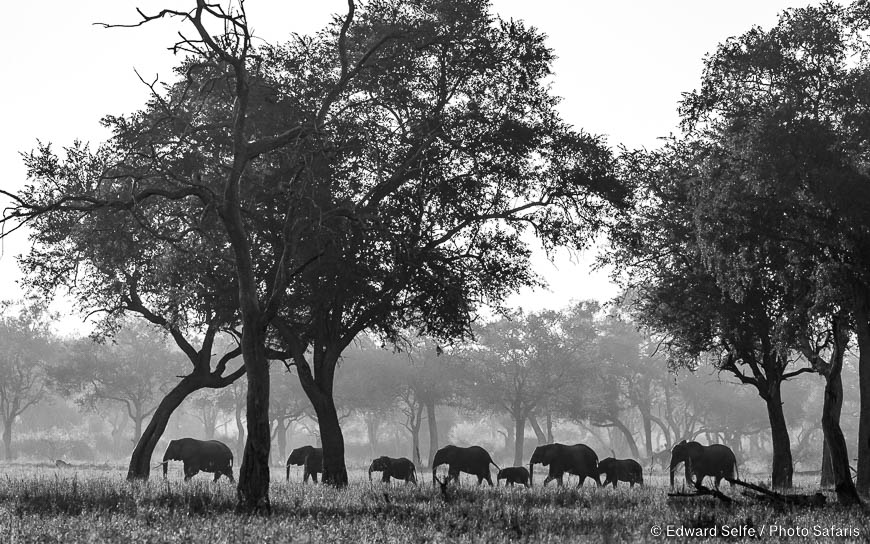
One of my favourite kinds of shot; late morning strong light, elephants against the sun — often a situation which would not yield a photo. And yet, by getting a bit of height (to see over the grass) and waiting for the right moment when all the elephants are distinct shapes, it’s possible to create something striking. Taken at a distance of at least 500m away.
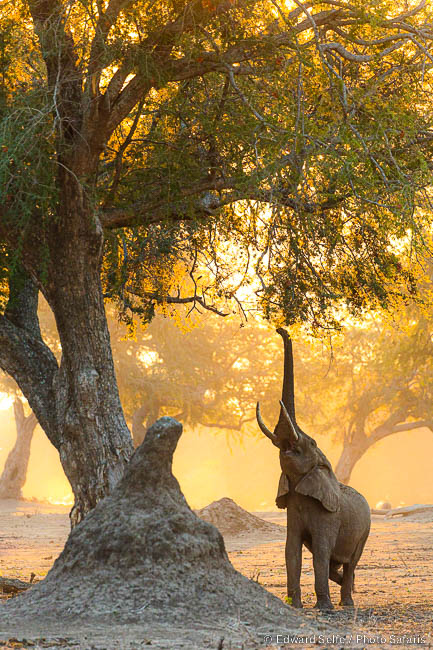
An all-time favourite elephant image; hot sultry afternoon in Mana Pools, sitting waiting for elephants to approach. The sun was behind a cloud and the light was less than optimal. As this last young bull reached into the winterthorn trees, the sun broke through and provided a dusty golden glow to the whole scene. The shape of the elephant, who is turned half-sideways, complements and fits with the shape of the large tree’s trunk.
Very many photographers have taken extraordinary images of elephants, and these are by no means the only techniques which work. But these are my “go to” techniques which usually yield a good image. Be ready to try totally different ideas and respond to the scene in front of you. Thank you for reading to the end.

